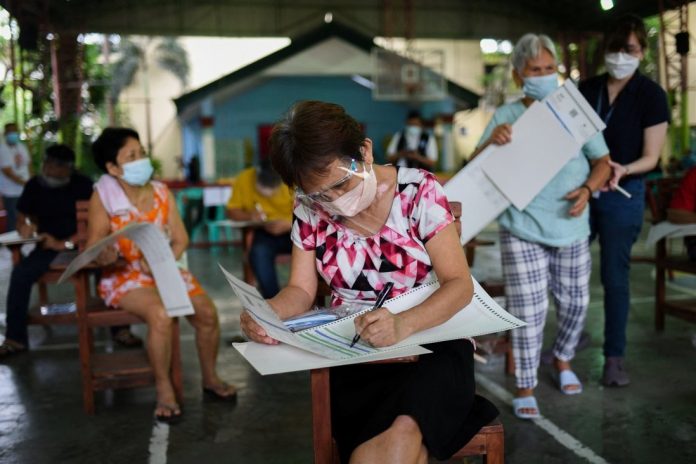When Filipinos go to the polls in May this year to elect a new leader, it could mark a shift in Manila’s position on the disputed South China Sea, and a turning point in the Philippines’ relations with the US – its security ally – and China, its largest trading partner.
Whoever replaces Rodrigo Duterte as president, and there are five leading contenders for the role, he or she will be faced with three dilemmas upon taking power.
First is how to expand economic relations with China to drive recovery from the Covid-19 pandemic while also pushing back against Beijing’s growing challenges to Manila’s maritime interests.
Second is how to strengthen security ties with the United States to support the Philippines’ military modernisation and defend its position in contested waters without overly antagonising Beijing.
Third is how to assess and react to US-led “mini-laterals” such as the Quad security grouping – with Australia, Japan and India – and the Aukus agreement – with Britain and Australia – without compromising Manila’s commitment to Asean centrality. The bloc of 10 nations has long taken pride in being at the core of Asia-Pacific regional architecture, but it is increasingly coming under stress from new security configurations. The Philippines’ skill in navigating this changing landscape will determine if it can rise to become a middle power able to exert considerable influence within its neighbourhood.
When it comes to China, attitudes remain mixed. There is clear recognition of the country’s growing role in the Philippine economy. In recent years, China has been the Philippines’ top source of imports, second-largest investor, and an active builder of infrastructure. It was even the Southeast Asian nation’s top export market for several months last year – demonstrating Beijing’s eagerness to reduce the trade imbalance with Manila by ramping up imports of Philippine electronic and agricultural goods. (In other months, either the US or Japan took the top spot.)
Thus, the question is no longer whether China can deliver on economic largesse, but whether this will leave Manila hamstrung in its foreign policy.
China is the driving force behind a number of potentially transformative projects currently under way in the Philippines, including the country’s first integrated steel mill and a new telecoms player that seeks to break the existing duopoly in the market. A China-funded dam promises to address Metro Manila’s water woes during the summer and mitigate flooding during the monsoon season. This year, work is set to start on the China-backed Subic-Clark cargo railway that aims to give a boost to Central Luzon’s economic zones and entice companies away from Manila’s notoriously congested ports. Elsewhere, a China-linked rail line is also planned for Mindanao, the Philippines’ second-largest island and home to its biggest agricultural plantations. All these factors raise the stakes for Manila keeping cordial ties with Beijing.
But this leads to the second dilemma – can Manila achieve balance and also bolster its ties with Washington, but do so in a way that does not result in it falling out of Beijing’s favour?
Washington supplies the Philippines with arms, provides training and intelligence, and supports its counterterrorism and maritime capacity building. The presence of US troops and hardware is also seen as a deterrent to Chinese ambitions, and provides for critical interoperability between allied militaries during uncertain times.
The US endorsed a 2016 arbitration award that overwhelmingly found in Manila’s favour – invalidating Beijing’s expansive claims and repudiating its disruptive activities in the South China Sea. Washington has also sought to marshal its allies and partners to pressure Beijing and frustrate it from achieving another fait accompli in the disputed waterway or the Taiwan Strait.
On the economic front, the US is the Philippines’ top investor, third-largest trade partner, and a key market for its flourishing business-process outsourcing sector. Hence, the enduring value of their alliance, and economic dimension of their relations, cannot be understated.
But alliances can also affect economics, as the deployment of a US Terminal High Altitude Area Defence (THAAD) missile shield in South Korea showed in 2017. That debacle strained Seoul’s ties with Beijing as South Korean retail and tourism suffered from a Chinese boycott.
Given the growing gulf between the US and China, the likelihood that Washington’s junior allies may suffer disproportionate economic collateral damage from possible Chinese retaliatory measures grows. Reluctance to rock the boat may have played into Manila’s trepidation to engage in joint patrols with US and allied navies in the South China Sea, especially without the rest of the Association of Southeast Asian Nations on board.
Implementation of a 2014 Enhanced Defence Cooperation Agreement between Washington and Manila has also been put on the spot, as plans for the Philippines to host US soldiers – and possibly weapons systems – for joint exercises will surely be on Beijing’s radar. Like Seoul, Manila may find itself on the receiving end of punitive actions should China oppose these moves.
Finally, Asean’s ambivalence towards the Quad and divisions over how to view Aukus complicate Manila’s reception of new security arrangements. As the US-China rivalry intensifies, regional countries are likely to double down on asserting Asean’s strategic autonomy.
How can the Philippines reconcile its position as a long-standing ally of the US, whose views on China are hardening by the day, and a founding member of Asean, which values it centrality and neutrality? This juggling act will test the diplomatic mettle of whoever becomes the Philippines’ new leader, and it’s something those in the running for the top job should now ponder seriously.
By Lucio Blanco Pitlo III / scmp
The views and opinions expressed in this article are solely those of the author and do not necessarily reflect the position of AsiaWE Review.




